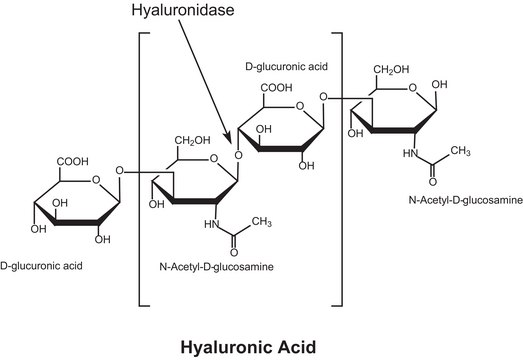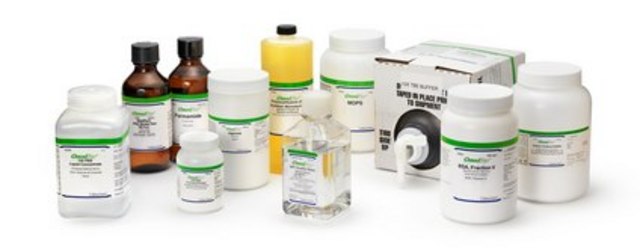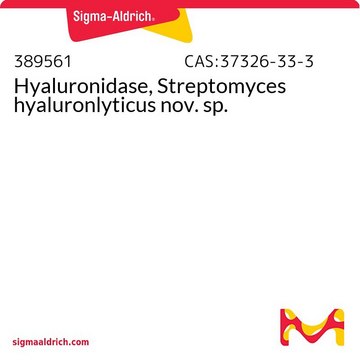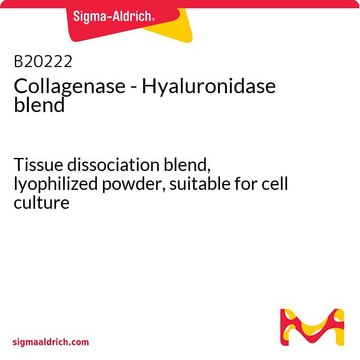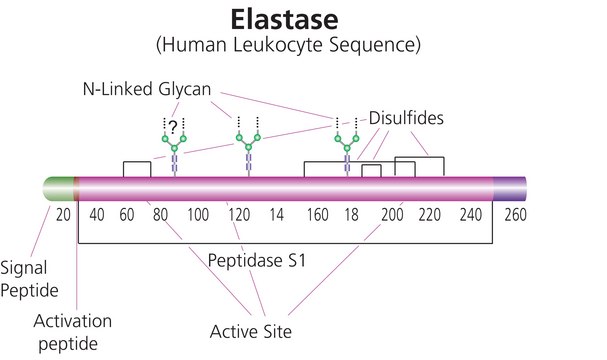56177
Hyaluronate Lyase from Streptococcus pyogenes
≥8.0 units/mg protein (5.0-15.0 mg/mL)
Synonym(s):
Hyaluronidase from Streptococcus pyogenes
Sign Into View Organizational & Contract Pricing
All Photos(1)
About This Item
CAS Number:
MDL number:
UNSPSC Code:
12352204
Recommended Products
recombinant
expressed in E. coli
form
liquid
specific activity
≥8.0 units/mg protein (5.0-15.0 mg/mL)
storage temp.
2-8°C
Biochem/physiol Actions
Hyaluronate lyase degrades hyaluronate using an elimination reaction to break glycosidic linkages yielding unsaturated disaccharide products. It is important for the diffusion of toxins and proteins produced by S. pyogenes.
Hyaluronate lyase degrades hyaluronate using an elimination reaction to break glycosidic linkages yielding unsaturated disaccharide products. It is important for the diffusion of toxins and proteins produced by S. pyogenes.
Unit Definition
1 U corresponds to the amount of enzyme which liberates 1 μmol unsaturated disaccharides per minute at pH 6.0 and 37°C from hyaluronic acid (Product No. 53747).
Physical form
ammonium sulfate suspension
Storage Class Code
12 - Non Combustible Liquids
WGK
WGK 2
Flash Point(F)
Not applicable
Flash Point(C)
Not applicable
Regulatory Information
新产品
Choose from one of the most recent versions:
Already Own This Product?
Find documentation for the products that you have recently purchased in the Document Library.
Structural studies on the bacterial lyase-resistant tetrasaccharides derived from the antithrombin III-binding site of porcine intestinal heparin.
Yamada, S., et al.
The Journal of Biological Chemistry, 4780-4787 (1993)
R J Linhardt et al.
Applied biochemistry and biotechnology, 12(2), 135-176 (1986-04-01)
Polysaccharide lyases (or eliminases) are a class of enzymes (EC 4.2.2.-) that act to cleave certain activated glycosidic linkages present in acidic polysaccharides. These enzymes act through an eliminase mechanism, rather than through hydrolysis, resulting in unsaturated oligosaccharide products. Acidic
Substrate specificity of the heparin lyases from Flavobacterium heparinum.
Desai, U.R., et al.
Archives of Biochemistry and Biophysics, 461-468 (1993)
Harshad V Joshi et al.
Proteins, 76(1), 30-46 (2008-12-18)
Hyaluronan lyase (Hyal) is a surface enzyme occurring in many bacterial organisms including members of Streptococcus species. Streptococcal Hyal primarily degrades hyaluronan-substrate (HA) of the extracellular matrix. This degradation appears to facilitate the spread of this bacterium throughout host tissues.
M J Jedrzejas
Cellular and molecular life sciences : CMLS, 64(21), 2799-2822 (2007-08-10)
Bacteria present a variety of molecules either on their surface or in a cell-free form. These molecules take part in numerous processes in the interactions with their host, with its tissues and other molecules. These molecules are essential to bacterial
Our team of scientists has experience in all areas of research including Life Science, Material Science, Chemical Synthesis, Chromatography, Analytical and many others.
Contact Technical Service